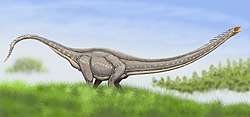Mamenchisauridae
Mamenchisauridae is a family of sauropod dinosaurs known from the Jurassic and Early Cretaceous of Asia and Africa.
| Mamenchisauridae | |
|---|---|
 | |
| Mamenchisaurus | |
| Scientific classification | |
| Kingdom: | Animalia |
| Phylum: | Chordata |
| Clade: | Dinosauria |
| Clade: | Saurischia |
| Suborder: | †Sauropodomorpha |
| Clade: | †Sauropoda |
| Clade: | †Eusauropoda |
| Family: | †Mamenchisauridae Young and Zhao, 1972 |
| Genera | |
| Synonyms | |
|
Omeisauridae Wilson, 2002 | |
Classification
The family Mamenchisauridae was first erected by Chinese paleontologists Yang Zhongjian ("C.C. Young") and Zhao Xijin in 1972, in a paper describing Mamenchisaurus hochuanensis.[2] Other members of Mamenchisauridae include Chuanjiesaurus, Datousaurus, Eomamenchisaurus, Huangshanlong, Hudiesaurus, Qijianglong, Tienshanosaurus, Omeisaurus, Tonganosaurus, Wamweracaudia, Xinjiangtitan, Yuanmousaurus, Zigongosaurus.
Paleogeography
Fossils of Mamenchisaurus and Omeisaurus have been found in the Shaximiao Formation, dating to the Oxfordian-Tithonian interval, around 159-150 Ma (million years ago). Chuanjiesaurus fossils date between 166.1-163.5 Ma, while those of Eomamenchisaurus were found in the Zhanghe Formation, believed to be around 175.6-161.2 million years old.[3] Fossils of Tonganosaurus date to even earlier, from the (Pliensbachian) Early Jurassic.[4] The Tendaguru taxon Wamweracaudia extends the geographic distribution of Mamenchisauridae into Africa,[5] while fossil remains from the Itat Formation suggest they also reached Siberia.[6] Additionally, an indeterminate cervical vertebra from the Phu Kradung Formation of Thailand demonstrates survival of Mamenchisauridae into the Cretaceous combined with new radiometric dates for the Suining Formation that has yielded fossils of Mamenchisaurus anyuensis.[7][8]
Paleobiology
Long-bone histology enables researchers to estimate the age that a specific individual reached. A study by Griebeler et al. (2013) examined long bone histological data and concluded that the unnamed mamenchisaurid SGP 2006/9 weighed 25,075 kilograms (27.6 short tons), reached sexual maturity at 20 years and died at age 31.[9]
References
- Jian-Dong Huang; Hai-Lu You; Jing-Tao Yang; Xin-Xin Ren (2014). "A new sauropod dinosaur from the Middle Jurassic of Huangshan, Anhui Province" (PDF). Vertebrata PalAsiatica. 52 (4): 390–400.
- Young, C.C. and Zhao, X. (1972). "Mamenchisaurus hochuanensis sp. nov.". Institute of Vertebrate Palaeontology and Palaeoanthropology Monographs Series A 8: 1-30.
- Lü, J., Li, T., Zhong, S., Ji, Q., and Li, S. (2008). "A new mamenchisaurid dinosaur from the Middle Jurassic of Yuanmou, Yunnan Province, China". Acta Geologica Sinica 82(1) :17-26.
- Li, K., Yang, C.-Y., Liu, J. and Wang, Z.-X. (2010). "A new sauropod dinosaur from the Lower Jyrassic of Huili, Sichuan, China." Vertebrata PalAsiatica, (3).
- Philip D Mannion, Paul Upchurch, Daniela Schwarz, Oliver Wings; Taxonomic affinities of the putative titanosaurs from the Late Jurassic Tendaguru Formation of Tanzania: phylogenetic and biogeographic implications for eusauropod dinosaur evolution, Zoological Journal of the Linnean Society, , zly068, https://doi.org/10.1093/zoolinnean/zly068
- Averianov, Alexander; Krasnolutskii, Sergei; Ivantsov, Stepan; Skutschas, Pavel; Schellhorn, Rico; Schultz, Julia; Martin, Thomas (2019). "Sauropod remains from the Middle Jurassic Itat Formation of West Siberia, Russia". PalZ. doi:10.1007/s12542-018-00445-8.
- Wang, J.; Norell, M. A.; Pei, R.; Ye, Y.; Chang, S.-C (2019). Surprisingly young age for the mamenchisaurid sauropods in South China. Cretaceous Research. doi:10.1016/j.cretres.2019.07.006.
- Suteethorn, S., Le Loeuff, J., Buffetaut, E., Suteethorn, V., and Wongko, K. 2013. First evidence of a mamenchisaurid dinosaur from the Upper Jurassic–Lower Cretaceous Phu Kradung Formation of Thailand. Acta Palaeontologica Polonica 58 (3): 459–469.
- Griebeler EM, Klein N, Sander PM (2013) Aging, Maturation and Growth of Sauropodomorph Dinosaurs as Deduced from Growth Curves Using Long Bone Histological Data: An Assessment of Methodological Constraints and Solutions. PLoS ONE 8(6): e67012. doi:10.1371/journal.pone.0067012
Sources
- Currie, Philip J.; Kevin Padian. Encyclopedia of Dinosaurs. p. 122.












